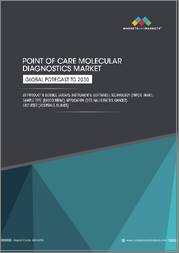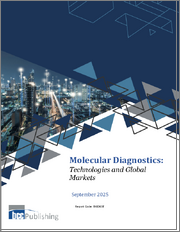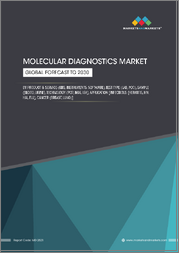
|
시장보고서
상품코드
1517446
세계의 코어 임상 분자진단 시장 : 규모 조사 제품 유형별, 기술별, 용도별, 지역별 예측(2022-2032년)Global Core Clinical Molecular Diagnostics Market Size study, by Product Type, by Technique (PCR, Nucleic Acid Sequencing, Fluorescence In Situ Hybridization, Others), by Application, and Regional Forecasts 2022-2032 |
||||||
코어 임상 분자진단 시장 규모는 2023년에 약 52억 6,000만 달러로 평가되었고 예측기간 동안 9.5% 이상의 견실한 성장률로 성장할 것으로 예측되고 있습니다.
코어 임상 분자진단은 유전 물질(DNA, RNA) 및 단백질을 분자 수준에서 분석하는 실험 기술을 포함합니다. 이러한 기술은 중합효소 연쇄반응(PCR), DNA 시퀀싱, 차세대 시퀀싱(NGS) 등을 포함하며, 맞춤형 의료에서의 질병 진단, 예후 예측,치료 선택에 필수적입니다. 유전자 돌연변이, 감염 인자, 질병 바이오마커를 확인함으로써, 이러한 진단 방법은 환자에 맞는 치료를 가능하게 하고 임상 결과를 향상시킵니다.
시장 확대의 주요 원동력은 감염과 종양 질환의 유병률 증가로 이어지는 노년 인구 증가입니다. 세계의보건기구(WHO)는 세계의 노인 인구가 2030년까지 14억 명에 달할 것으로 예측하고 있으며, 분자 수준에서 질병을 감지할 수 있는 고급 진단 기술의 필요성을 강조하고 있습니다. 이러한 인구 역학의 변화는 질병 유병률 증가와 이에 따른 분자진단 검사에 대한 수요 증가를 뒷받침합니다. 또한, 세계의 건강 관리 지출 증가는 임상 분자진단 약물 시장의 성장을 지원합니다. 건강 관리 지출이 증가함에 따라 첨단 진단 기술에 대한 투자도 증가하고 있습니다. 헬스케어 제공업체는 환자의 케어와 결과를 최적화하기 때문에 정확하고 시기 적절한 진단을 우선하고 있으며, 특히 고령화가 진행되고 질병 부담이 큰 지역에서는 그 경향이 현저합니다. 게다가 시퀀싱 기술의 향상, 검출법의 감도 향상, 멀티플렉스 분석의 개발 등의 기술 진보는 진단의 속도와 정밀도를 높이는 것으로 시장의 성장을 더욱 뒷받침하고 있습니다.
그러나 초기 투자 비용이 높고 지역에 따라 액세스 및 인프라에 제한이 있기 때문에 시장 성장을 방해할 수 있습니다. 고급 분자진단 기술은 큰 이점을 제공하지만, 그 비용은 일부 건강 관리 제공업체에게 놀라운 것일 수 있습니다. 또한, 특정 지역에서는 인프라가 충분하지 않으며 이러한 기술에 대한 제한된 액세스가 도입의 장벽이되었습니다. 이러한 문제를 해결하기 위해서는 핵심 분자진단 기술에 대한 공정한 접근을 보장하기 위해 비용 절감, 인프라 개선 및 접근성 향상을 위해 노력해야 합니다.
코어 임상 분자진단의 시장 조사에서 고려한 주요 지역은 북미, 유럽, 아시아태평양의, 라틴아메리카의, 중동, 아프리카의입니다. 북미는 세계의 코어 임상 분자진단 시장에서 지배적인 지역입니다. 이 이점은 주로 이 지역의 선진 건강 관리 인프라, R&D에 대한 엄청난 투자, 주요 시장 기업의 존재 때문입니다. 미국은 첨단 진단 기술의 채용률이 높고 분자진단의 기술 혁신을 지원하는 규제 프레임워크이 확립되어 있습니다. 또한 암이나 감염과 같은 만성 질환의 확산은 정확하고 조기 진단 솔루션 수요에 박차를 가하고 있습니다. 유전체 연구에 대한 왕성한 자금 공급과 맞춤형 의료의 보급은 임상 분자진단 시장의 핵심을 차지하는 북미의 지위를 더욱 높여줍니다. 아시아태평양의은 견조한 경제 발전, 급속한 인구 증가, 건강 관리 의식 증가로 견인되어 예측 기간 동안 가장 빠른 성장을 보일 것으로 예상됩니다. 이 지역의 건강 관리 인프라 개선과 코어 임상 분자진단제에 대한 수요가 증가함에 따라 시장 성장에 기여하고 있습니다.
목차
제1장 코어 임상 분자진단 시장 주요 요약
- 코어 임상 분자진단 시장 규모와 예측(2022년-2032년)
- 지역별 개요
- 부문별 개요
- 제품 유형별
- 기술별
- 용도별
- 주요 동향
- 불황의 영향
- 애널리스트의 결론 및 제안
제2장 코어 임상 분자진단 시장 정의와 조사의 전제조건
- 조사 목적
- 시장의 정의
- 조사의 전제조건
- 포함과 제외
- 제한 사항
- 공급측 분석
- 가용성
- 인프라
- 규제 환경
- 시장 경쟁
- 경제성(소비자의 시점)
- 수요측 분석
- 규제 프레임워크
- 기술의 진보
- 환경에의 배려
- 소비자의 의식과 수용
- 조사 방법
- 조사 대상년도
- 환율 변환율
제3장 코어 임상 분자진단 시장 역학
- 시장 성장 촉진요인
- 질병의 유병률 증가
- 헬스케어 지출 증가
- 시장의 과제
- 초기 투자비용 높이
- 접근성과 인프라 제한
- 시장 기회
- 기술의 진보
- 규제 당국의 지원과 계발 프로그램
제4장 코어 임상 분자진단 시장 산업 분석
- Porter's Five Forces 모델
- 공급기업의 협상력
- 구매자의 협상력
- 신규 진입업자의 위협
- 대체품의 위협
- 경쟁 기업간 경쟁 관계
- Porter's Five Forces모델에 대한 미래적 접근
- Porter's Five Forces의 영향 분석
- PESTEL 분석
- 정치
- 경제
- 사회
- 기술
- 환경
- 법률
- 주요 투자 기회
- 주요 성공 전략
- 파괴적 동향
- 업계 전문가의 시점
- 애널리스트의 결론 및 제안
제5장 코어 임상 분자진단 시장 : 제품 유형별 시장 규모와 예측(2022년-2032년)
- 부문 대시보드
- 코어 임상 분자진단 시장 제품 유형별 수익 동향 분석(2022년,2032년)
- 기기
- 시약
- 소프트웨어 및 서비스
제6장 코어 임상 분자진단 시장 : 기술별 시장 규모와 예측(2022년-2032년)
- 부문 대시보드
- 코어 임상 분자진단 시장 기술별 수익 동향 분석(2022년,2032년)
- PCR법
- 핵산 시퀀싱
- 형광 in situ 하이브리드화(FISH)
- 기타
제7장 코어 임상 분자진단 시장 규모,용도별 예측(2022년-2032년)
- 부문 대시보드
- 코어 임상 분자진단 시장 용도 수익 동향 분석(2022년,2032년)
- 감염증
- 유전자 질환
- 암 스크리닝
- 기타
제8장 코어 임상 분자진단 시장 규모와 예측(2022년-2032년)
- 북미의 코어 임상 분자진단 약물 시장
- 미국
- 제품 유형별 시장 규모 및 예측(2022년-2032년)
- 기술내역 : 시장 규모 및 예측(2022년-2032년)
- 용도 내역 : 시장 규모 및 예측(2022년-2032년)
- 캐나다 임상 분자진단 약물 핵심 시장
- 멕시코 코어 임상 분자진단 시장
- 미국
- 유럽 임상 분자진단 코어 시장
- 독일 코어 임상 분자진단 시장
- 영국의 코어 임상 분자진단 시장
- 프랑스 코어 임상 분자진단 시장
- 스페인 코어 임상 분자진단 시장
- 이탈리아 코어 임상 분자진단 시장
- 기타 유럽 코어 임상 분자진단 시장
- 아시아태평양 코어 임상 분자진단 시장
- 중국 임상 분자진단 코어 시장
- 인도 코어 임상 분자진단 시장
- 일본의 임상 분자 코어 진단 시장
- 호주 임상 분자진단 약물 핵심 시장
- 한국 코어 임상 분자진단 시장
- 기타 아시아태평양의 코어 임상 분자진단 시장
- 라틴아메리카 임상 분자진단 약물 핵심 시장
- 브라질 임상 분자진단 약물 핵심 시장
- 멕시코 코어 임상 분자진단 시장
- 기타 라틴아메리카의 코어 임상 분자진단 약물 시장
- 중동 및 아프리카 코어 임상 분자진단 시장
- 사우디아라비아 코어 임상 분자진단 약물 시장
- 남아프리카 코어 임상 분자진단 시장
- 기타 중동 및 아프리카의 임상 분자진단약 핵심 시장
제9장 경쟁 정보
- 주요 기업의 SWOT 분석
- 주요 시장 전략
- 기업 프로파일
- BioMerieux SA
- 주요 정보
- 개요
- 재무(데이터의 이용가능성에 따름)
- 제품 개요
- 시장 전략
- Novartis AG
- Becton Dickinson & Company
- Siemens Healthineers AG
- Abbott Laboratories
- Hologic, Inc.
- Cepheid AB
- Qiagen NV.
- Agilent Technologies, Inc.
- F. Hoffmann La Roche
- PerkinElmer, Inc.
- Luminex Corporation
- Bio-Rad Laboratories, Inc.
- Illumina, Inc.
- Roche Diagnostics
- BioMerieux SA
제10장 조사 과정
- 조사 과정
- 데이터 마이닝
- 분석
- 시장 추정
- 검증
- 출판
- 조사 속성
The Global Core Clinical Molecular Diagnostics Market is valued at approximately USD 5.26 billion in 2023 and is anticipated to grow with a healthy growth rate of more than 9.5% over the forecast period 2024-2032. Core clinical molecular diagnostics involve the use of laboratory techniques to analyze genetic material (DNA, RNA) and proteins at the molecular level. These techniques include Polymerase Chain Reaction (PCR), DNA sequencing, and Next-Generation Sequencing (NGS), essential for disease diagnosis, prognosis, and treatment selection in personalized medicine. By identifying genetic variations, infectious agents, and disease biomarkers, these diagnostics enable tailored patient care and enhance clinical outcomes.
The market's expansion is primarily driven by the increasing geriatric population, which leads to a higher prevalence of infectious and oncological disorders. The World Health Organization projects that the global elderly population will reach 1.4 billion by 2030, emphasizing the need for advanced diagnostic technologies capable of detecting diseases at the molecular level. This demographic shift underscores the escalating prevalence of diseases and the subsequent demand for molecular diagnostic tests. Moreover, rising healthcare expenditure globally supports the growth of the core clinical molecular diagnostics market. As healthcare spending increases, there is greater investment in advanced diagnostic technologies. Healthcare providers prioritize accurate and timely diagnosis to optimize patient care and outcomes, especially in regions with aging populations and higher disease burdens. Additionally, technological advancements, such as improved sequencing techniques, enhanced sensitivity of detection methods, and development of multiplex assays, further drive the market's growth by increasing the speed and accuracy of diagnoses.
However, the high initial investment costs and limitations in accessibility and infrastructure in certain regions may hinder market growth. While advanced molecular diagnostic technologies offer significant benefits, their cost may be prohibitive for some healthcare providers. Additionally, inadequate infrastructure and limited access to these technologies in certain regions pose barriers to adoption. Addressing these challenges requires efforts to reduce costs, improve infrastructure, and enhance accessibility to ensure equitable access to core molecular diagnostic technologies.
Key regions considered in the Global Core Clinical Molecular Diagnostics Market study include North America, Europe, Asia Pacific, Latin America, and the Middle East & Africa. North America is the dominant region in the Global Core Clinical Molecular Diagnostics Market. This dominance is primarily due to the region's advanced healthcare infrastructure, significant investment in research and development, and the presence of major market players. The United States has a high adoption rate of advanced diagnostic technologies and a well-established regulatory framework that supports innovation in molecular diagnostics. Additionally, the growing prevalence of chronic diseases, such as cancer and infectious diseases, has spurred the demand for accurate and early diagnostic solutions. The robust funding for genomic research and the widespread implementation of personalized medicine further contribute to North America's leading position in the core clinical molecular diagnostics market. The Asia-Pacific region is expected to exhibit the fastest growth during the forecast period, driven by robust economic development, a rapidly expanding population, and increasing healthcare awareness. The region's improving healthcare infrastructure and rising demand for core clinical molecular diagnostics further contribute to market growth.
Major market players included in this report are:
- BioMerieux SA
- Novartis AG
- Becton Dickinson & Company
- Siemens Healthineers AG
- Abbott Laboratories
- Hologic, Inc.
- Cepheid AB
- Qiagen NV.
- Agilent Technologies, Inc.
- F. Hoffmann La Roche
- PerkinElmer, Inc.
- Luminex Corporation
- Bio-Rad Laboratories, Inc.
- Illumina, Inc.
- Roche Diagnostics
The detailed segments and sub-segment of the market are explained below:
By Product Type:
- Instruments
- Reagents
- Software & Services
By Technique:
- PCR
- Nucleic Acid Sequencing
- Fluorescence In Situ Hybridization (FISH)
- Others
By Application:
- Infectious Diseases
- Genetic Disorders
- Cancer Screening
- Others
By Region:
- North America
- U.S.
- Canada
- Europe
- Germany
- France
- UK
- Italy
- Spain
- Rest of Europe
- Asia-Pacific
- China
- Japan
- India
- Australia
- South Korea
- Rest of Asia-Pacific
- Latin America
- Brazil
- Mexico
- Rest of Latin America
- Middle East & Africa
- Saudi Arabia
- South Africa
- Rest of Middle East & Africa
Years considered for the study are as follows:
- Historical year - 2022
- Base year - 2023
- Forecast period - 2024 to 2032
Key Takeaways:
- Market Estimates & Forecast for 10 years from 2022 to 2032.
- Annualized revenues and regional level analysis for each market segment.
- Detailed analysis of geographical landscape with Country level analysis of major regions.
- Competitive landscape with information on major players in the market.
- Analysis of key business strategies and recommendations on future market approach.
- Analysis of competitive structure of the market.
- Demand side and supply side analysis of the market.
Table of Contents
Chapter 1. Global Core Clinical Molecular Diagnostics Market Executive Summary
- 1.1. Global Core Clinical Molecular Diagnostics Market Size & Forecast (2022-2032)
- 1.2. Regional Summary
- 1.3. Segmental Summary
- 1.3.1. By Product Type
- 1.3.2. By Technique
- 1.3.3. By Application
- 1.4. Key Trends
- 1.5. Recession Impact
- 1.6. Analyst Recommendation & Conclusion
Chapter 2. Global Core Clinical Molecular Diagnostics Market Definition and Research Assumptions
- 2.1. Research Objective
- 2.2. Market Definition
- 2.3. Research Assumptions
- 2.3.1. Inclusion & Exclusion
- 2.3.2. Limitations
- 2.3.3. Supply Side Analysis
- 2.3.3.1. Availability
- 2.3.3.2. Infrastructure
- 2.3.3.3. Regulatory Environment
- 2.3.3.4. Market Competition
- 2.3.3.5. Economic Viability (Consumer's Perspective)
- 2.3.4. Demand Side Analysis
- 2.3.4.1. Regulatory frameworks
- 2.3.4.2. Technological Advancements
- 2.3.4.3. Environmental Considerations
- 2.3.4.4. Consumer Awareness & Acceptance
- 2.4. Estimation Methodology
- 2.5. Years Considered for the Study
- 2.6. Currency Conversion Rates
Chapter 3. Global Core Clinical Molecular Diagnostics Market Dynamics
- 3.1. Market Drivers
- 3.1.1. Increasing Prevalence of Diseases
- 3.1.2. Rising Healthcare Expenditure
- 3.2. Market Challenges
- 3.2.1. High Initial Investment Cost
- 3.2.2. Accessibility and Infrastructure Limitations
- 3.3. Market Opportunities
- 3.3.1. Technological Advancements
- 3.3.2. Regulatory Support and Awareness Programs
Chapter 4. Global Core Clinical Molecular Diagnostics Market Industry Analysis
- 4.1. Porter's 5 Force Model
- 4.1.1. Bargaining Power of Suppliers
- 4.1.2. Bargaining Power of Buyers
- 4.1.3. Threat of New Entrants
- 4.1.4. Threat of Substitutes
- 4.1.5. Competitive Rivalry
- 4.1.6. Futuristic Approach to Porter's 5 Force Model
- 4.1.7. Porter's 5 Force Impact Analysis
- 4.2. PESTEL Analysis
- 4.2.1. Political
- 4.2.2. Economical
- 4.2.3. Social
- 4.2.4. Technological
- 4.2.5. Environmental
- 4.2.6. Legal
- 4.3. Top investment opportunity
- 4.4. Top winning strategies
- 4.5. Disruptive Trends
- 4.6. Industry Expert Perspective
- 4.7. Analyst Recommendation & Conclusion
Chapter 5. Global Core Clinical Molecular Diagnostics Market Size & Forecasts by Product Type 2022-2032
- 5.1. Segment Dashboard
- 5.2. Global Core Clinical Molecular Diagnostics Market: Product Type Revenue Trend Analysis, 2022 & 2032 (USD Billion)
- 5.2.1. Instruments
- 5.2.2. Reagents
- 5.2.3. Software & Services
Chapter 6. Global Core Clinical Molecular Diagnostics Market Size & Forecasts by Technique 2022-2032
- 6.1. Segment Dashboard
- 6.2. Global Core Clinical Molecular Diagnostics Market: Technique Revenue Trend Analysis, 2022 & 2032 (USD Billion)
- 6.2.1. PCR
- 6.2.2. Nucleic Acid Sequencing
- 6.2.3. Fluorescence In Situ Hybridization (FISH)
- 6.2.4. Others
Chapter 7. Global Core Clinical Molecular Diagnostics Market Size & Forecasts by Application 2022-2032
- 7.1. Segment Dashboard
- 7.2. Global Core Clinical Molecular Diagnostics Market: Application Revenue Trend Analysis, 2022 & 2032 (USD Billion)
- 7.2.1. Infectious Diseases
- 7.2.2. Genetic Disorders
- 7.2.3. Cancer Screening
- 7.2.4. Others
Chapter 8. Global Core Clinical Molecular Diagnostics Market Size & Forecasts by Region 2022-2032
- 7.1. North America Core Clinical Molecular Diagnostics Market
- 7.1.1. U.S. Core Clinical Molecular Diagnostics Market
- 7.1.1.1. Product Type breakdown size & forecasts, 2022-2032
- 7.1.1.2. Technique breakdown size & forecasts, 2022-2032
- 7.1.1.3. Application breakdown size & forecasts, 2022-2032
- 7.1.2. Canada Core Clinical Molecular Diagnostics Market
- 7.1.3. Mexico Core Clinical Molecular Diagnostics Market
- 7.1.1. U.S. Core Clinical Molecular Diagnostics Market
- 7.2. Europe Core Clinical Molecular Diagnostics Market
- 7.2.1. Germany Core Clinical Molecular Diagnostics Market
- 7.2.2. UK Core Clinical Molecular Diagnostics Market
- 7.2.3. France Core Clinical Molecular Diagnostics Market
- 7.2.4. Spain Core Clinical Molecular Diagnostics Market
- 7.2.5. Italy Core Clinical Molecular Diagnostics Market
- 7.2.6. Rest of Europe Core Clinical Molecular Diagnostics Market
- 7.3. Asia-Pacific Core Clinical Molecular Diagnostics Market
- 7.3.1. China Core Clinical Molecular Diagnostics Market
- 7.3.2. India Core Clinical Molecular Diagnostics Market
- 7.3.3. Japan Core Clinical Molecular Diagnostics Market
- 7.3.4. Australia Core Clinical Molecular Diagnostics Market
- 7.3.5. South Korea Core Clinical Molecular Diagnostics Market
- 7.3.6. Rest of Asia Pacific Core Clinical Molecular Diagnostics Market
- 7.4. Latin America Core Clinical Molecular Diagnostics Market
- 7.4.1. Brazil Core Clinical Molecular Diagnostics Market
- 7.4.2. Mexico Core Clinical Molecular Diagnostics Market
- 7.4.3. Rest of Latin America Core Clinical Molecular Diagnostics Market
- 7.5. Middle East & Africa Core Clinical Molecular Diagnostics Market
- 7.5.1. Saudi Arabia Core Clinical Molecular Diagnostics Market
- 7.5.2. South Africa Core Clinical Molecular Diagnostics Market
- 7.5.3. Rest of Middle East & Africa Core Clinical Molecular Diagnostics Market
Chapter 9. Competitive Intelligence
- 9.1. Key Company SWOT Analysis
- 9.2. Top Market Strategies
- 9.3. Company Profiles
- 9.3.1. BioMerieux SA
- 9.3.1.1. Key Information
- 9.3.1.2. Overview
- 9.3.1.3. Financial (Subject to Data Availability)
- 9.3.1.4. Product Summary
- 9.3.1.5. Market Strategies
- 9.3.2 Novartis AG
- 9.3.3. Becton Dickinson & Company
- 9.3.4. Siemens Healthineers AG
- 9.3.5. Abbott Laboratories
- 9.3.6. Hologic, Inc.
- 9.3.7. Cepheid AB
- 9.3.8. Qiagen NV.
- 9.3.9. Agilent Technologies, Inc.
- 9.3.10. F. Hoffmann La Roche
- 9.3.11. PerkinElmer, Inc.
- 9.3.12. Luminex Corporation
- 9.3.13. Bio-Rad Laboratories, Inc.
- 9.3.14. Illumina, Inc.
- 9.4.15. Roche Diagnostics
- 9.3.1. BioMerieux SA
Chapter 10. Research Process
- 10.1. Research Process
- 10.1.1. Data Mining
- 10.1.2. Analysis
- 10.1.3. Market Estimation
- 10.1.4. Validation
- 10.1.5. Publishing
- 10.2. Research Attributes

















